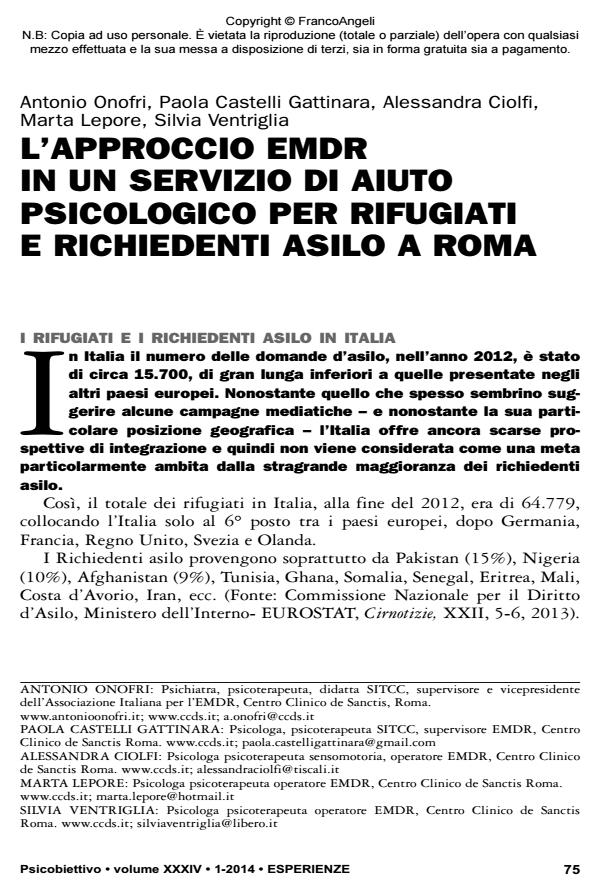L’approccio EMDR in un servizio di aiuto psicologico per rifugiati e richiedenti asilo a Roma
Titolo Rivista PSICOBIETTIVO
Autori/Curatori Antonio Onofri, Paola Castelli Gattinara, Alessandra Ciolfi, Marta Lepore, Silvia Ventriglia
Anno di pubblicazione 2014 Fascicolo 2014/1
Lingua Italiano Numero pagine 21 P. 75-95 Dimensione file 571 KB
DOI 10.3280/PSOB2014-001006
Il DOI è il codice a barre della proprietà intellettuale: per saperne di più
clicca qui
Qui sotto puoi vedere in anteprima la prima pagina di questo articolo.
Se questo articolo ti interessa, lo puoi acquistare (e scaricare in formato pdf) seguendo le facili indicazioni per acquistare il download credit. Acquista Download Credits per scaricare questo Articolo in formato PDF

FrancoAngeli è membro della Publishers International Linking Association, Inc (PILA)associazione indipendente e non profit per facilitare (attraverso i servizi tecnologici implementati da CrossRef.org) l’accesso degli studiosi ai contenuti digitali nelle pubblicazioni professionali e scientifiche
Gli Autori descrivono brevemente i sintomi psichiatrici più comuni in un campione particolare di immigrati, quello dei rifugiati e richiedenti asilo. Riportano quindi la alta frequenza di reazioni post-traumatiche complesse (Herman, 1997) in questa popolazione clinica, caratterizzata da eventi traumatici molteplici, prolungati e spesso di natura interpersonale. Particolare importanza assumono i disturbi da somatizzazione e quindi quegli interventi terapeutici in grado di tenere in attenta considerazione il corpo. Dopo una breve rassegna della letteratura riguardante la psicoterapia per i rifugiati e i richiedenti asilo, gli autori riferiscono prima la storia istituzionale di un ambulatorio ospedaliero per i disturbi da stress post-traumatico e di un servizio di aiuto psicologico specificamente rivolto a questa popolazione clinica; quindi descrivono un protocollo di intervento terapeutico con l’approccio EMDR svolto "per fasi" e inizialmente centrato sulla stabilizzazione del paziente, sulla attivazione di risorse personali, sul controllo dei sintomi ansiosi e dissociativi, sul miglioramento dei sintomi corporei e solo in un secondo momento sulla rielaborazione e integrazione dei ricordi traumatici (Shapiro, 2012). L’articolo è corredato dal resoconto clinico di tre casi singoli particolarmente esemplificativi.
Parole chiave:EMDR; rifugiati; richiedenti asilo; PTSD; trauma complesso; disturbi da somatizzazione.
Antonio Onofri, Paola Castelli Gattinara, Alessandra Ciolfi, Marta Lepore, Silvia Ventriglia, L’approccio EMDR in un servizio di aiuto psicologico per rifugiati e richiedenti asilo a Roma in "PSICOBIETTIVO" 1/2014, pp 75-95, DOI: 10.3280/PSOB2014-001006